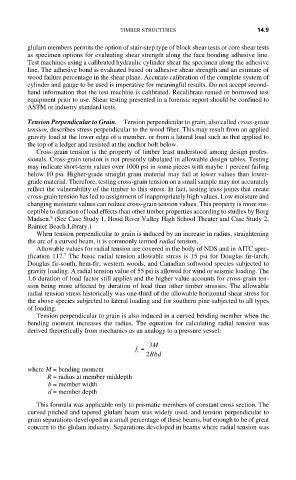Page 518 - Forensic Structural Engineering Handbook
P. 518
TIMBER STRUCTURES 14.9
glulam members permits the option of stair-step type of block shear tests or core shear tests
as specimen options for evaluating shear strength along the face bonding adhesive line.
Test machines using a calibrated hydraulic cylinder shear the specimen along the adhesive
line. The adhesive bond is evaluated based on adhesive shear strength and an estimate of
wood failure percentage in the shear plane. Accurate calibration of the complete system of
cylinder and gauge to be used is imperative for meaningful results. Do not accept second-
hand information that the test machine is calibrated. Recalibrate rented or borrowed test
equipment prior to use. Shear testing presented in a forensic report should be confined to
ASTM or industry standard tests.
Tension Perpendicular to Grain. Tension perpendicular to grain, also called cross-grain
tension, describes stress perpendicular to the wood fiber. This may result from an applied
gravity load at the lower edge of a member, or from a lateral load such as that applied to
the top of a ledger and resisted at the anchor bolt below.
Cross-grain tension is the property of timber least understood among design profes-
sionals. Cross-grain tension is not presently tabulated in allowable design tables. Testing
may indicate short-term values over 1000 psi in some pieces with maybe 1 percent failing
below 10 psi. Higher-grade straight grain material may fail at lower values than lower-
grade material. Therefore, testing cross-grain tension on a small sample may not accurately
reflect the vulnerability of the timber to this stress. In fact, testing truss joints that create
cross-grain tension has led to assignment of inappropriately high values. Low moisture and
changing moisture values can reduce cross-grain tension values. This property is more sus-
ceptible to duration of load effects than other timber properties according to studies by Borg
8
Madsen. (See Case Study 1, Hood River Valley High School Theater and Case Study 2,
Rainier Beach Library.)
When tension perpendicular to grain is induced by an increase in radius, straightening
the arc of a curved beam, it is commonly termed radial tension.
Allowable values for radial tension are covered in the body of NDS and in AITC spec-
7
ification 117. The basic radial tension allowable stress is 15 psi for Douglas fir-larch,
Douglas fir-south, hem-fir, western woods, and Canadian softwood species subjected to
gravity loading. A radial tension value of 55 psi is allowed for wind or seismic loading. The
1.6 duration of load factor still applies and the higher value accounts for cross-grain ten-
sion being more affected by duration of load than other timber stresses. The allowable
radial tension stress historically was one-third of the allowable horizontal shear stress for
the above species subjected to lateral loading and for southern pine subjected to all types
of loading.
Tension perpendicular to grain is also induced in a curved bending member when the
bending moment increases the radius. The equation for calculating radial tension was
derived theoretically from mechanics as an analogy to a pressure vessel:
3 M
f =
r
2 Rbd
where M = bending moment
R = radius at member middepth
b = member width
d = member depth
This formula was applicable only to prismatic members of constant cross section. The
curved pitched and tapered glulam beam was widely used, and tension perpendicular to
grain separations developed in a small percentage of these beams, but enough to be of great
concern to the glulam industry. Separations developed in beams where radial tension was

